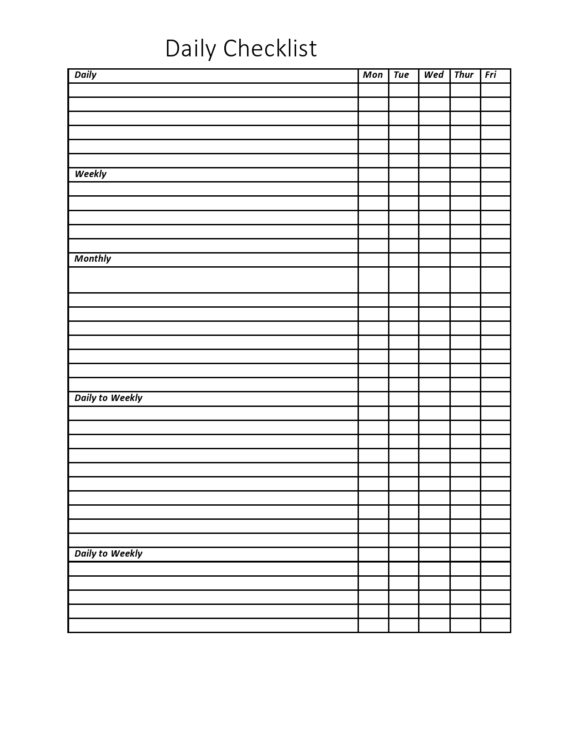
You can also find Google Forms through Google Drive. To get started with Google Forms, head over to this landing page and sign into your Google account.

Although I’ll take you through steps using this tool in the blog post, you can use Microsoft Forms essentially the same way. What is Google Forms? Google Forms is a Google Tool that lets you create a survey-style data entry form. Let’s dive into the steps for creating a digital checklist with Google Forms. Creating my own Google Form gave me the power to create a digital checklist that was completely customized to my organizational needs. I loved the idea of using forms to make my own system for keeping track of information.
#Check off list download
Download a ready-made checklist template in the free web-based application Google Docs where documents and spreadsheets can be created, edited, and stored online. To avoid this circumstance, you need a checklist to keep you in the right direction. Start with this checklist and, if necessary, adapt it to your retail store. Sometimes, we find ourselves off track and lost with the multiple tasks we have. Whether it’s you, a store manager, or a sales associate that’s responsible for ticking these items off the list, outlining the duties will make the process easier.

Way before Google Classroom came into the equation, I started playing around with Google Forms. Start your day off on the right foot by creating a retail store opening checklist. phrasal verb with check verb uk / tek / us. Forum discussions with the word (s) 'check off' in the title: Check / Checking off a list. As I sat in with students working in small groups, I would have my clipboard nearby to jot down a note or record an observation. Synonyms: mark off, check, verify, notice, mark, more. Instead, I used clipboards with checklists on each one to keep track of formative assessment data. Now this wasn’t in the walk around a silent classroom tapping on the edge of my clipboard sort of way. This is a strategy I often share in workshops and webinars when talking about ways to keep track of information.Īs a classroom teacher in pre-device days, I was a big clipboard person. In this blog post, I’ll share one of my favorite ways to use Google Forms and take you through the steps to create a digital checklist. And that will take you to achieve your ultimate goals.Google Forms is one of my favorite tools because it is super customizable and can help you stay organized. If you break your goals into projects, your projects into tasks, and these-if they are too large-into micro-tasks, you will have a list of things you can check off. That way, you deceive your brain to not avoid the important tasks.
#Check off list full
You will enter a steady flow of work, full of small rewards that push you to continue until the end. Check off each micro-task as you complete it and go adding at the end of the list the next micro-tasks that emerge. A small tick or checkmark is drawn in the box after the item.

Simply, take a piece of paper and write down the next movements that your task at hand needs to get done. Checklists are often presented as lists with small checkboxes down the left hand side of the page. You don’t have to enter these micro-tasks in your organizational system (that wouldn’t be very productive). Micro-tasks are small movements of work, lasting on the order of several minutes, that lead you to complete the task. Want to be even more productive? Divide your tasks into micro-tasks. Use these templates to create a classic task list for a day and always have a clear roadmap as well as understanding of what to do next on one page. The solution, of course, is to break down these long and difficult tasks into many smaller, more manageable tasks, so that they can be tackled in the short-term. Although you know that you’re doing the most important thing at this time, your Next Actions list not only does not decrease but increases progressively as a result of new demands that require your attention.īut the truth is that most of the activities that add value to your life and your work are not minor or easy. The worst thing is that you will feel great, you will have the feeling that you’ve done a lot (which is true) and think you’ll have had a very productive day (which is not true).Įngaging in a long and complicated task can be very frustrating. If you don’t know how your brain works and don’t exert some control over it, this phenomenon will always take you to try to do the smaller and easier tasks on your to-do list. This release of dopamine not only makes you feel good but also motivates you to continue completing tasks and extend that pleasant feeling.īut this does not help you be more productive by itself. The reason is that whenever you recognize a task or project as completed, your brain releases a load of dopamine, a neurotransmitter that is responsible for generating feelings of accomplishment, satisfaction and happiness. Crossing out tasks or marking them as completed with a simple √ within a to-do list makes you feel great.


 0 kommentar(er)
0 kommentar(er)
